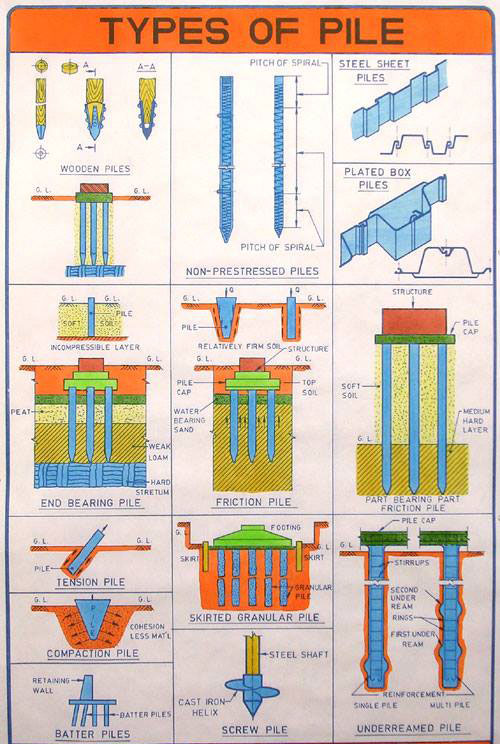Types of Piles for Pile Foundation
- Concrete Cost Estimator
- Concrete Continuous Footing
- Landscape Bidding and Estimating
- Construction Cost Estimating
- Concrete and steel cost estimation
- Construction Cost Estimate Breakdown
- Construction Estimating Worksheet
- Home Construction Cost Estimate
- Estimate Pricing Sheet
- Sheet for General Contractor
- Construction Cost Estimate
- Labor Materials Cost Estimator
- Masonry Estimating Sheet
- Sheet for Building Contractor
- Construction Schedule Bar chart
- General Cost Estimator Sheet
- General Construction Estimate
- Building and Road Estimating Sheet
- Detailed expense estimates
- Door and Window Takeoff Sheet
- General Construction Cost Estimating Sheet

Piles are can categorized based on the following attributes: 1. Mechanism of Load Transfer (Also See: Load Capacity of Piles) 2. Installation Method 3. Sort of Materials
Categorization of Piles due to load transfer: categories of piles are based on the method of Load Transfer -
End/Point Bearing Piles: When a bedrock or similar type of material exists in a site within a logical depth, piles are expanded to the rock surface. Here, the utmost bearing capacity of the pile is obtained on the basis of the elementary material; therefore the piles are defined as end or point bearing piles. In these types of cases the desired length of the pile is reasonably set up.
In place of bedrock, if a moderately condensed and hard layer of soil is assembled at a rational depth, piles can be broadened to a few meters into the hard layer.
Friction Piles: In friction piles, the load on pile is obstructed due to skin/friction resistance alongside the side of the pile (pile shaft). Pure friction piles seem to be reasonably lengthy, being the load-carrying. Capacity refers to a function of the shaft area adjacent to the soil. In congruity less soils, like sands of medium to low density, friction piles are frequently applied to enhance the density as well as the shear strength. When there is no layer of rock or rocklike material at a logical depth at a site, point/end bearing piles turn out to be very elongated and wasteful. To cope with this type of subsoil condition, piles are absorbed forcefully during the softer material to specified depth.
Friction cum end bearing piles: In most of the cases, the load-carrying capacity is reliant on both end-bearing and shaft friction.
Driven or displacement piles: They are generally created in advance prior to being induced, jacked, screwed or hammered into ground. This category contains driven piles of steel or precast concrete and piles produced with driving tubes or shells which are connected through a driving shoe. After that, the tubes or shells are filled with concrete. In this category there exist piles generated through placing concrete once the driven piles are removed.
Bored or Replacement piles: These type of piles need a hole to be punched through initially and at this stage the pile is then generally created with reinforced concrete. Based on the soil type, the shaft (bore) may be consoled or despoiled.
Get more information on Types of Piles based on Materials

- Application of concrete calculator
- Roofing Calculator can streamline the roof estimating process
- House construction cost calculator
- Engineering column design excel spreadsheet
- Material Estimating Sheet with Excel
- Materials List and Cost Estimate Worksheet
- Concrete Slab Estimating Calculator Sheet
- Common types of foundations for buildings
- Online calculation of construction materials
- Estimating with Excel for the Small Contractor
- Concrete Beam Design Spreadsheet
- Virtual Construction Management app for construction
- Autodesk’s Project Skyscraper
- Reed Construction’s Reed Insight
- Manage your construction project documentation
- Costimator, the popular cost estimating software
- On Center Software for construction professionals
- Free Construction Estimating Software
- Plumbing Calc Pro
- Cost Estimate Worksheet
- HVAC Piping Quantity Takeoff Worksheet
- Construction Estimating Software Sheet
- Estimate Cost Templates
- Construction Punch List
- Construction cost estimating template consisting estimating basic
- Gantt Chart Template for Excel
- Download Civil Engineering Spreadsheets with Verification
- The Building Advisor Estimating and Budgeting Worksheet
- Spreadsheet for design of concrete bridge
- Construction Estimating Software Free








